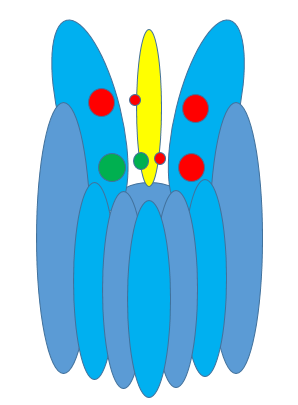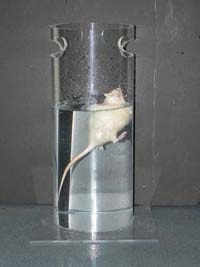SA-4503 on:
[Wikipedia]
[Google]
[Amazon]
Cutamesine (SA 4503) is a synthetic


sigma receptor
Sigma receptors (σ-receptors) are protein receptors that bind ligands such as 4-PPBP (4-phenyl-1-(4-phenylbutyl) piperidine), SA 4503 (cutamesine), ditolylguanidine, dimethyltryptamine, and siramesine. There are two subtypes, sigma-1 rec ...
agonist
An agonist is a chemical that activates a Receptor (biochemistry), receptor to produce a biological response. Receptors are Cell (biology), cellular proteins whose activation causes the cell to modify what it is currently doing. In contrast, an R ...
which is selective for the ''σ''1 receptor, a chaperone protein
In molecular biology, molecular chaperones are proteins that assist the conformational folding or unfolding of large proteins or macromolecular protein complexes. There are a number of classes of molecular chaperones, all of which function to assi ...
mainly found in the endoplasmic reticulum
The endoplasmic reticulum (ER) is a part of a transportation system of the eukaryote, eukaryotic cell, and has many other important functions such as protein folding. The word endoplasmic means "within the cytoplasm", and reticulum is Latin for ...
of cells in the central nervous system
The central nervous system (CNS) is the part of the nervous system consisting primarily of the brain, spinal cord and retina. The CNS is so named because the brain integrates the received information and coordinates and influences the activity o ...
. These ''σ''1 receptors play a key role in the modulation of Ca2+ release and apoptosis. Cutamesine's activation of the ''σ''1 receptor is tied to a variety of physiological phenomena in the CNS, including activation of dopamine-releasing neurons and repression of the MAPK/ERK pathway.
Structure
The molecular formula for cutamesine is C23H32N2O2. This particular agonist is apiperazine
Piperazine () is an organic compound with the formula . In term of its structure, it can be described as cyclohexane with the 1- and 4-CH2 groups replaced by NH. Piperazine exists as deliquescent solid with a saline taste. Piperazine is freely sol ...
, meaning that its core functional group is a six-membered heterocycle with two oppositely-placed nitrogen atoms. Two phenalkyl groups act as substituents for the two nitrogen atoms. The phenethyl group has methoxy group
In organic chemistry, a methoxy group is the functional group consisting of a methyl group bound to oxygen. This alkoxy group has the formula .
On a benzene ring, the Hammett equation classifies a methoxy substituent at the ''para'' position a ...
s on the 3 and 4 locations of the aromatic ring, while the phenpropyl group has no additional functional groups attached.
Affinity
Causes of Affinity
The 3,4-methoxy groups located on the phenethyl group play an important role in ''σ'' receptor binding affinity, with alterations made to these groups leading to changes in affinity to ''σ''1. Replacement side groups that possess the moststeric bulk
Steric effects arise from the spatial arrangement of atoms. When atoms come close together there is generally a rise in the energy of the molecule. Steric effects are nonbonding interactions that influence the shape ( conformation) and reactivi ...
have the lowest binding affinity for the ''σ''1 receptor. The nitrogen atoms in the molecule play a central role in its affinity, as removal of these nitrogen atoms results in a lack of affinity to ''σ''1. N(b) - the nitrogen in the piperazine attached to the longest substituent - plays a much greater role in binding affinity than N(a). Sigma receptors are defined by the presence of one amine binding site and three hydrophobic binding sites nearby in the ligand-binding region. Thus, the N(b) atom in the central piperazine ring serves to interact with the amine binding site and the two phenethyl groups serve to fill two out of the three hydrophobic pockets.
Binding Trends
Cutamesine exhibits high binding affinity for the ''σ''1 receptor, with greatly reduced affinity for the ''σ''2 receptor. It acts as a competitive inhibitor for (+)- Hentazocine.Haloperidol
Haloperidol, sold under the brand name Haldol among others, is a typical antipsychotic medication. Haloperidol is used in the treatment of schizophrenia, tics in Tourette syndrome, mania in bipolar disorder, delirium, agitation, acute psychos ...
and NE-100 antagonize cutamesine-induced cholinergic (acetylcholine
Acetylcholine (ACh) is an organic compound that functions in the brain and body of many types of animals (including humans) as a neurotransmitter. Its name is derived from its chemical structure: it is an ester of acetic acid and choline. Par ...
) facilitation. Cutamesine likely does not interact directly with cholinergic receptors, as its binding affinity for them is nearly non-existent. It can also bind to vertebral emopamil binding protein (EBP). Although EBP exists at a lower density in the brain than ''σ''1 receptors, cutamesine exhibits higher affinity for the former.
Physiological Effects
Memory and Amnesia
It has been shown that cutamesine has anti-amnesic properties and could be used to reduce the effects of amnesia caused byREM sleep
Rapid eye movement sleep (REM sleep or REMS) is a unique phase of sleep in mammals (including humans) and birds, characterized by random rapid movement of the eyes, accompanied by low muscle tone throughout the body, and the propensity of the s ...
deprivation. Decreases in the memory function of rats caused by the presence of scopolamine
Scopolamine, also known as hyoscine, or Devil's Breath, is a medication used to treat motion sickness and postoperative nausea and vomiting. It is also sometimes used before surgery to decrease saliva. When used by injection, effects begin a ...
has been shown to be mitigated by the introduction of SA 4503. The activation of the MAPK/ERK (mitogen-activated protein kinase/extracellular signal-regulated kinase) pathway in neurons is repressed by SA 4503, which in turn leads to reduced stress-related cell death. The presence of SA 4503 has a positive impact on the number of active dopaminergic neurons
Dopaminergic cell groups, DA cell groups, or dopaminergic nuclei are collections of neurons in the central nervous system that synthesize the neurotransmitter dopamine. In the 1960s, dopaminergic neurons or ''dopamine neurons'' were first identi ...
in the frontal cortex
The frontal lobe is the largest of the four major lobes of the brain in mammals, and is located at the front of each cerebral hemisphere (in front of the parietal lobe and the temporal lobe). It is parted from the parietal lobe by a groove betw ...
, which is linked to improved memory function.
Depression
''σ''1 receptors are of interest to scientists studying the neurology of depression, as certain antidepressants (ADs) exhibit high affinity for these receptors and ''σ''1 receptor agonists such as SA 4503 have displayed activity similar to that of ADs in non-human trials. The function of dopaminergic systems has been linked to the effectiveness of ADs, and many experiments involving cutamesine have revolved around dopamine. The presence of SA 4503 has been linked to increases in the concentration of dopamine and dihydroxyphenylacetic acid (a metabolite of dopamine) in the frontal cortex. Cutamesine may assist with the release of dopamine from presynaptic neurons in the frontal cortex. For rodents, there was a negative correlation between SA 4503 levels and immobility time during a forced swimming test.Heart
The administration of cutamesine has been shown to mitigate the effects of cardiachypertrophy
Hypertrophy is the increase in the volume of an organ or tissue due to the enlargement of its component cells. It is distinguished from hyperplasia, in which the cells remain approximately the same size but increase in number. Although hypertro ...
. Angiotensin II
Angiotensin is a peptide hormone that causes vasoconstriction and an increase in blood pressure. It is part of the renin–angiotensin system, which regulates blood pressure. Angiotensin also stimulates the release of aldosterone from the ...
-induced hypertrophy results in lower ATP production and smaller mitochondrial size in cardiomyocytes
Cardiac muscle (also called heart muscle or myocardium) is one of three types of vertebrate muscle tissues, the others being skeletal muscle and smooth muscle. It is an involuntary, striated muscle that constitutes the main tissue of the wall of ...
, and introduction of SA 4503 returns both ATP production and mitochondrial size to baseline.
Hearing
The presence of cutamesine is positively correlated with the presence ofhippocampal
The hippocampus (: hippocampi; via Latin from Greek , 'seahorse'), also hippocampus proper, is a major component of the brain of humans and many other vertebrates. In the human brain the hippocampus, the dentate gyrus, and the subiculum ar ...
brain‐derived neurotrophic factor
Neurotrophic factors (NTFs) are a family of biomolecules – nearly all of which are peptides or small proteins – that support the growth, survival, and differentiation of both developing and mature neurons. Most NTFs exert their trop ...
(BDNF). Due to the relationship between the presence of BDNF and ciliary neurotrophic factor and the preservation of auditory nerves, it is thought that cutamesine may have a positive effect on the health of the cochlea. Despite the apparent auditory benefits of cutamesine treatment, it does not prevent hearing loss that is a result of aging.See also
*Mefeclorazine
Mefeclorazine () is a neuroleptic (antipsychotic) of the phenethylamine and arylpiperazine groups.
Part of mefeclorazine's chemical structure is based on 3,4-dimethoxyphenethylamine (DMPEA or homoveratrylamine), which has structural similari ...
*Vanoxerine
Vanoxerine is an investigational drug which is being evaluated for the treatment of heart arrhythmias and cocaine dependence. Vanoxerine is a piperazine derivative which has multiple pharmacological activities including acting as an dopamine re ...
(shares same phenylpropyl group attached to piperazine)References
External links
* {{Phenethylamines Methoxyphenethylamines Piperazines Sigma agonists Catechol ethers Phenethylamines Methoxy compounds